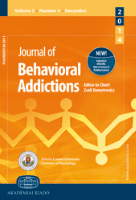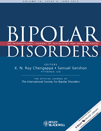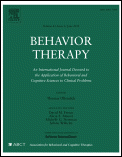
Journal of Behavioral Addictions
Scope & Guideline
Illuminating the Pathways of Behavioral Addictions
Introduction
Aims and Scopes
- Behavioral Addiction Research:
The journal publishes studies that explore various forms of behavioral addictions, including but not limited to internet gaming, gambling, smartphone use, and compulsive sexual behavior. It seeks to understand the underlying psychological, social, and biological mechanisms that contribute to these conditions. - Clinical Implications and Treatment Approaches:
Research that evaluates treatment methodologies and interventions for behavioral addictions is a key focus. The journal highlights empirical studies, meta-analyses, and clinical trials that assess the effectiveness of therapeutic approaches, including cognitive-behavioral therapy, mindfulness interventions, and pharmacological treatments. - Neurobiological Underpinnings:
The journal features studies that investigate the neurobiological correlates of behavioral addictions, utilizing advanced imaging techniques and neuropsychological assessments. This includes research on brain structure and function in relation to addictive behaviors. - Cultural and Societal Perspectives:
The journal emphasizes the importance of cultural and societal factors in understanding behavioral addictions. It encourages research that examines how different cultural contexts influence the prevalence, perception, and treatment of behavioral addictions. - Risk Factors and Prevention Strategies:
Research focusing on identifying risk factors associated with the development of behavioral addictions is integral to the journal. It also highlights studies that propose and evaluate prevention strategies aimed at reducing the incidence of these disorders.
Trending and Emerging
- Impact of COVID-19 on Behavioral Addictions:
Research exploring the effects of the COVID-19 pandemic on behavioral addictions has surged. Studies investigate how lockdowns and increased screen time have exacerbated issues such as internet gaming disorder and smartphone addiction. - Technological Influences on Addiction:
There is a growing body of literature examining how technological advancements, such as social media, online gaming, and gambling apps, contribute to addiction behaviors. This includes investigations into specific features that enhance engagement and potential addiction. - Neuroscientific Approaches to Understanding Addictions:
Emerging research utilizing neuroimaging and electrophysiological methods is on the rise. These studies aim to elucidate the brain mechanisms underlying various behavioral addictions, providing insights into treatment and intervention strategies. - Cultural Contexts of Behavioral Addictions:
There is an increasing emphasis on cultural and contextual factors influencing behavioral addictions. Researchers are exploring how cultural norms, societal pressures, and familial influences shape the prevalence and treatment of addiction behaviors. - Intersection of Behavioral Addictions and Mental Health:
Recent publications highlight the co-occurrence of behavioral addictions with mental health issues, such as anxiety, depression, and ADHD. This trend underscores the importance of integrated treatment approaches that address both addiction and mental health.
Declining or Waning
- Traditional Substance Use Comparisons:
Studies that compare behavioral addictions with substance use disorders, particularly in terms of treatment and outcomes, have become less frequent. This shift may indicate a growing recognition of behavioral addictions as distinct entities warranting independent research. - Focus on Non-Digital Addictions:
There has been a notable reduction in papers addressing non-digital behavioral addictions, such as compulsive shopping or exercise addiction. This decline may reflect an increased focus on digital and internet-related addictions, particularly in the context of the COVID-19 pandemic. - Generalized Addiction Models:
Research that utilizes broad, generalized models of addiction without specific focus on behavioral nuances has waned. The journal now favors more nuanced approaches that consider the specific characteristics and contexts of different behavioral addictions. - Longitudinal Studies of Older Populations:
There has been a decrease in longitudinal studies examining behavioral addictions in older populations. This may indicate a shift toward focusing on younger demographics, particularly adolescents and young adults, who are often more susceptible to digital addiction trends.
Similar Journals

JOURNAL OF CLINICAL PSYCHOLOGY
Elevating Mental Health Research and PracticeThe JOURNAL OF CLINICAL PSYCHOLOGY, published by Wiley, has been a pivotal resource in the field of psychological research since its inception in 1945. With an impressive impact factor and classification within the Q1 category for both Arts and Humanities and Clinical Psychology, it ranks prominently at #54/552 in Arts and Humanities and #71/311 in Clinical Psychology according to Scopus, placing it in the top percentiles for both categories. The journal primarily serves as a platform for disseminating groundbreaking research, theoretical advancements, and practical applications pertinent to clinical psychology, making it indispensable for researchers, clinicians, and scholars dedicated to enhancing mental health practices. Although not an open-access journal, it provides critical insights and methodologies that are fundamental for professionals navigating the complexities of clinical psychology today. With a commitment to advancing understanding and treatment of psychological disorders, the journal continues to shape outcomes in mental health and therapeutic practices.

Current Addiction Reports
Advancing knowledge in addiction research.Current Addiction Reports, published by SPRINGERNATURE, is a leading journal dedicated to the comprehensive study of addiction in its various dimensions, with a particular focus on the latest clinical developments and research in Clinical Psychology and Psychiatry and Mental Health. Since its inception in 2014 and through to 2024, the journal has established itself as a pivotal resource for researchers, professionals, and students alike, currently holding a prestigious Q1 ranking in both relevant categories. With an impressive Scopus rank of #46 in Clinical Psychology and #129 in Psychiatry and Mental Health, it occupies a significant position within the field, reflecting its commitment to high-quality scholarship and impactful findings. The journal offers open access options, ensuring that vital research is readily available to a global audience. By fostering a deeper understanding of addiction trends and innovative treatment methodologies, Current Addiction Reports plays an essential role in advancing knowledge and improving clinical practices.

BEHAVIOURAL BRAIN RESEARCH
Connecting Behavior with Neural MechanismsBEHAVIOURAL BRAIN RESEARCH, published by Elsevier, is a leading scholarly journal that has been at the forefront of research in Behavioral Neuroscience since its inception in 1980. With an ISSN of 0166-4328 and an e-ISSN of 1872-7549, this journal caters to a global audience of researchers and professionals keen on exploring the intricate relationships between behavior and neural processes. As of 2023, it holds an impressive Q2 ranking within its category, showcasing its significant impact with a Scopus rank of #28 out of 88 in the field, placing it in the 68th percentile. While the journal does not offer open access, it remains accessible through institutional subscriptions, ensuring that its high-quality research is disseminated effectively. The journal's commitment to advancing knowledge in behavioral neuroscience makes it an indispensable resource for those looking to delve deep into the complexities of brain-behavior interactions and foster innovative approaches in both research and clinical applications.

Iranian Journal of Psychiatry and Behavioral Sciences
Advancing Mental Health Insights for a Global DialogueIranian Journal of Psychiatry and Behavioral Sciences, published by BRIEFLAND, is a pivotal platform for scholars and practitioners in the fields of psychiatry and behavioral sciences. With its ISSN 1735-8639 and E-ISSN 1735-9287, this journal primarily caters to the Iranian context while fostering a global dialogue on contemporary issues in mental health, behavioral neurology, and biological psychiatry. Since its inception in 2007, the journal has committed to disseminating high-quality research and reviews, thereby contributing to its categorization in the fourth quartile (Q4) for both Behavioral Neuroscience and Biological Psychiatry as of 2023. Although currently lacking an open access model, the journal's accessibility to critical research discussions is vital for enhancing knowledge among researchers, professionals, and students alike. With emerging relevance in the Iranian mental health landscape, it aims to bridge gaps in understanding and promote evidence-based practices from 2007 to 2024 and beyond.

Molecular Autism
Exploring the genetic landscape of autism spectrum disorders.Molecular Autism, published by BMC in the United Kingdom, is a premier open-access journal dedicated to publishing high-quality research on the molecular and genetic factors contributing to autism spectrum disorders. Since its inception in 2010, the journal has established itself as a vital resource for researchers and clinicians, offering insights into the developmental biology, neuroscience, and psychiatric dimensions of autism. With an impressive impact factor and rankings placing it in the Q1 category across multiple relevant fields such as Developmental Biology, Developmental Neuroscience, Molecular Biology, and Psychiatry and Mental Health, it serves as a critical platform for the dissemination of innovative research and interdisciplinary collaboration. The journal encourages open dialogue through its commitment to making research freely accessible, thereby advancing knowledge and fostering advances in the understanding of autism. By bridging diverse disciplines and engaging with cutting-edge research, Molecular Autism aims to enhance our understanding of autism's complexities and inform future therapeutic approaches.

Sexual Health & Compulsivity
Advancing Understanding of Sexual Health DynamicsSexual Health & Compulsivity, published by Routledge Journals, Taylor & Francis Ltd, is a pivotal platform for researchers, clinicians, and students focusing on the complex interplay between sexual behavior and mental health. With its emphasis on the latest findings and theoretical advancements in the fields of Clinical Psychology and Psychiatry, this journal aspires to foster a deeper understanding of sexual health issues and compulsivity. As part of its mission, the journal offers open access options, ensuring wide dissemination of knowledge and research findings. Though it operates from the United Kingdom and boasts an HIndex yet to be established, its current ranking positions it within the Q3 category for Clinical Psychology and Q4 for Psychiatry and Mental Health, reflecting its growing visibility and relevance. Recognizing the importance of addressing sexual health in clinical practice, Sexual Health & Compulsivity is committed to promoting scholarly dialogue and advancing ethical frameworks pertinent to complex sexual behaviors through comprehensive research published from 2021 to 2024.

BIPOLAR DISORDERS
Fostering Breakthroughs in Bipolar ResearchBIPOLAR DISORDERS, published by Wiley, is a leading international journal dedicated to advancing the understanding and treatment of bipolar disorders. Since its establishment in 1999, the journal has become a vital resource in the fields of Biological Psychiatry and Psychiatry and Mental Health, currently ranked in the Q2 category for Biological Psychiatry and Q1 for Psychiatry and Mental Health as of 2023. With impressive Scopus rankings, it stands at 75th out of 567 in Psychiatry and Mental Health and 11th out of 51 in Biological Psychiatry, reflecting its influential role in shaping mental health research. The journal not only focuses on empirical studies, reviews, and clinical reports but also encourages innovative methodological advancements in understanding bipolar disorders. Although it does not offer Open Access, its extensive coverage from 1999 to 2024 ensures that practitioners, researchers, and students have access to a wealth of knowledge critical for the development of effective therapeutic interventions. For those engaging with cutting-edge research in psychiatric care, BIPOLAR DISORDERS serves as an essential platform for knowledge dissemination and academic discourse.

BEHAVIOR THERAPY
Exploring New Frontiers in Psychological TreatmentBehavior Therapy, published by Elsevier Inc, is a premier journal in the field of Clinical Psychology, recognized for its significant contributions to the empirical understanding and practical application of behavior therapy interventions. With an impressive impact factor ranking it in the Q1 quartile of Clinical Psychology as of 2023, and a commendable position in the 87th percentile among its peers, this journal serves as a vital resource for researchers, practitioners, and students alike. Since its inception in 1970, Behavior Therapy has dedicated itself to publishing high-quality original research, comprehensive reviews, and insightful case studies that cover the latest advancements in treatment modalities and behavioral interventions. The journal is committed to fostering a deeper understanding of psychological processes and therapeutic techniques, making it an essential platform for innovative ideas and effective practices in the realm of behavior therapy.

Journal of Behavioral and Cognitive Therapy
Transforming therapy with evidence-based practices.Journal of Behavioral and Cognitive Therapy, published by ELSEVIER, is an esteemed academic journal dedicated to advancing the fields of clinical psychology, neuropsychology, and psychiatry through rigorous research and innovative practices. With an ISSN of 2589-9791 and Q2 rankings in both Clinical Psychology and Neuropsychology as of 2023, it demonstrates a strong commitment to fostering high-quality, impactful scholarship. Holding a Scopus Rank of 129 among 311 in Clinical Psychology, this journal serves as a significant platform for researchers and practitioners to disseminate their findings and engage in vital discussions surrounding behavioral and cognitive therapies. The journal's scope encompasses an array of topics pertinent to mental health, providing valuable insights that empower professionals and students alike. Although not Open Access, articles published within this journal have the potential to reach a diverse audience across the globe, enhancing collaboration and knowledge exchange in the critical arena of mental health. Located in France, the Journal of Behavioral and Cognitive Therapy continues to contribute to the global discourse on evidence-based practices and therapeutic innovations.

ADDICTION
Connecting research with clinical excellence in addiction.ADDICTION, published by Wiley, is a highly regarded academic journal that serves the vibrant fields of Medicine and Psychiatry and Mental Health. With an impressive impact factor reflective of its significance—ranking in the top 8% and 7.5% of its categories respectively—this journal is esteemed for its rigorous peer-reviewed research which spans a wide array of topics related to addiction, including pharmacology, prevention, and treatment modalities. Since its inception in 1993, ADDICTION has continually provided a platform for innovative research, shaping the discourse and influencing clinical practices worldwide. This journal, based in the United Kingdom at a prestigious location in Hoboken, NJ, stands as a beacon for researchers, practitioners, and students alike, committed to advancing understanding and strategies to combat addiction-related challenges. Although it is not an Open Access publication, the journal's contribution to the field remains invaluable, ensuring that cutting-edge findings are disseminated widely among professionals dedicated to improving mental health outcomes.